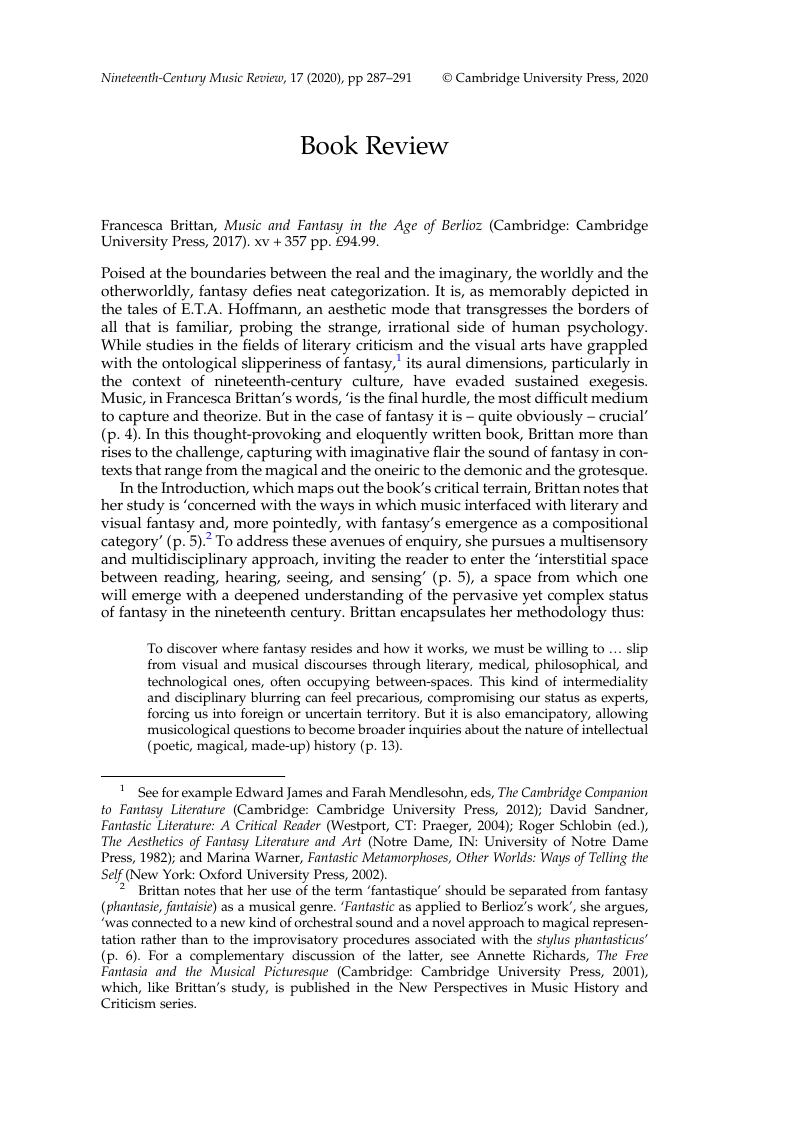No CrossRef data available.
Published online by Cambridge University Press: 24 March 2020

1 See for example James, Edward and Mendlesohn, Farah, eds, The Cambridge Companion to Fantasy Literature (Cambridge: Cambridge University Press, 2012)CrossRefGoogle Scholar; Sandner, David, Fantastic Literature: A Critical Reader (Westport, CT: Praeger, 2004)Google Scholar; Schlobin, Roger (ed.), The Aesthetics of Fantasy Literature and Art (Notre Dame, IN: University of Notre Dame Press, 1982)Google Scholar; and Warner, Marina, Fantastic Metamorphoses, Other Worlds: Ways of Telling the Self (New York: Oxford University Press, 2002)Google Scholar.
2 Brittan notes that her use of the term ‘fantastique’ should be separated from fantasy (phantasie, fantaisie) as a musical genre. ‘Fantastic as applied to Berlioz's work’, she argues, ‘was connected to a new kind of orchestral sound and a novel approach to magical representation rather than to the improvisatory procedures associated with the stylus phantasticus’ (p. 6). For a complementary discussion of the latter, see Richards, Annette, The Free Fantasia and the Musical Picturesque (Cambridge: Cambridge University Press, 2001)Google Scholar, which, like Brittan's study, is published in the New Perspectives in Music History and Criticism series.
3 Chapters 2 and 6 are developed from the following articles: Brittan, Francesca, ‘Berlioz and the Pathological Fantastic: Melancholy, Monomania, and Romantic Autobiography’, 19th-Century Music 29/3 (2006): 211–39CrossRefGoogle Scholar; and Brittan, , ‘On Microscopic Hearing: Fairy Magic, Natural Science, and the Scherzo fantastique’, Journal of the American Musicological Society 64/3 (2011): 527–600CrossRefGoogle Scholar.
4 For more on this concept, see Webber, Andrew J., The Doppelgänger: Double Visions in German Literature (Oxford: Clarendon Press, 1996), Chapter 3CrossRefGoogle Scholar, ‘Hoffmann's Chronic Dualisms’.
5 See Head, Matthew, ‘C.P.E. Bach “In Tormentis”: Gout Pain and Body Language in the Fantasia in A Major, H278 (1782)’, Eighteenth-Century Music 13/2 (2016): 211–34CrossRefGoogle Scholar.
6 See Guin, Elisabeth Le, Boccherini's Body: An Essay in Carnal Musicology (Berkeley: University of California Press, 2005)CrossRefGoogle Scholar.
7 See Davies, James Q., Romantic Anatomies of Performance (Berkeley: University of California Press, 2014)CrossRefGoogle Scholar.